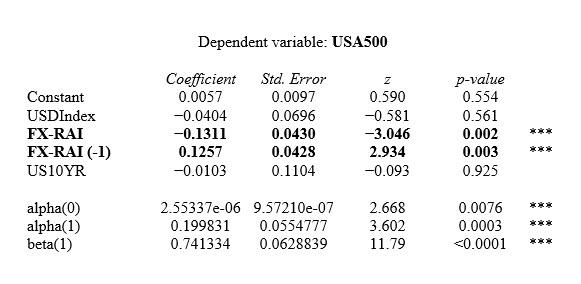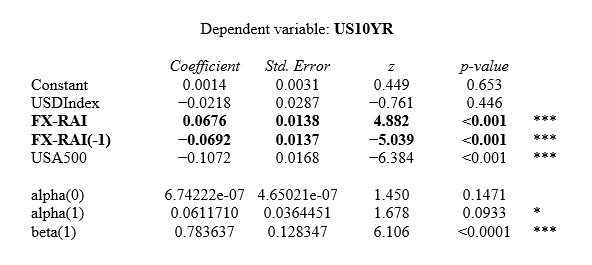Last week, I gave an overview of the FX Risk Aversion index (FX-RAI). As discussed in the post, an increase in the FX-RAI translates into a higher cost of capital, given that banks and businessmen are not willing to lend, something which can potentially have a negative effect on business investment. This expected behaviour translates into more demand for financial instruments which have less risk and less demand for instruments which are riskier. In other words, we expect that during periods of higher Risk Aversion stock markets would fall while bond prices would rise. Can we statistically confirm these relationships and, if so, how would the FX-RAI perform?
To answer the first part of this question, a statistical analysis of the FX-RAI with the USA500 and the US10YR bond confirms what we had suggested in the previous post. The first table of this post indicates that the FX-RAI has a negative relationship with the stock market. Interestingly, the relationship could turn positive on the following day, suggesting the possibility of reversals. On a similar note, the FX-RAI has the expected positive relationship with the US10YR bond price (table below): as Risk Aversion increases demand for safer goods (bonds) increases and hence their price will increase. In contrast, the bond yield is expected to decrease as bond prices rise.
What does this tell us then? Simply put, it suggests that when a Risk Aversion state settles in the markets, profitable opportunities still exist for the careful trader. One just needs to be alert to identify both the duration of the Risk Aversion spell as well as to be prepared as to how to adjust his or her strategies.
*Model estimation details: The sample employed ranges from 21 March 2017 to 18 September 2018. Lags of the dependent variable were also included where needed to ensure that no autocorrelation issues exist. All variables have been transformed using the first difference of the natural logarithm. The Gretl software was used to estimate all models.
Click here to access the HotForex Economic calendar.
Want to learn to trade and analyse the markets? Join our webinars and get analysis and trading ideas combined with better understanding on how markets work. Click HERE to register for FREE! The next webinar will start in:
[ujicountdown id=”Next Webinar” expire=”2018/10/23 14:00″ hide=”true” url=”” subscr=”” recurring=”” rectype=”second” repeats=””]
Dr Nektarios Michail
Market Analyst
HotForex
Disclaimer: This material is provided as a general marketing communication for information purposes only and does not constitute an independent investment research. Nothing in this communication contains, or should be considered as containing, an investment advice or an investment recommendation or a solicitation for the purpose of buying or selling of any financial instrument. All information provided is gathered from reputable sources and any information containing an indication of past performance is not a guarantee or reliable indicator of future performance. Users acknowledge that any investment in FX and CFDs products is characterized by a certain degree of uncertainty and that any investment of this nature involves a high level of risk for which the users are solely responsible and liable. We assume no liability for any loss arising from any investment made based on the information provided in this communication. This communication must not be reproduced or further distributed without our prior written permission.




















